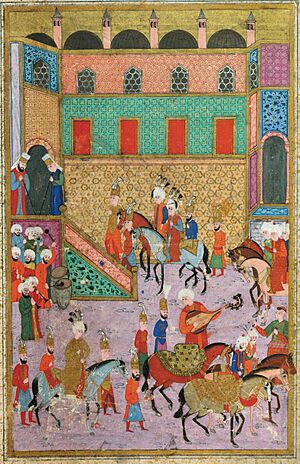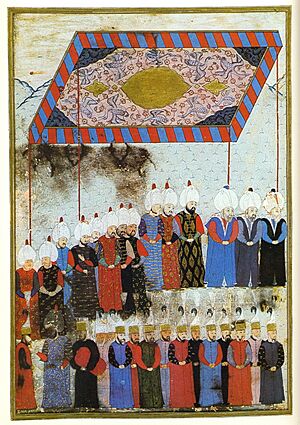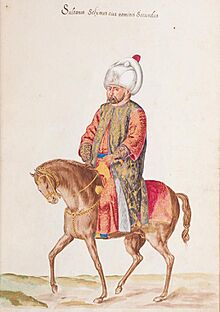Selim II facts for kids
Quick facts for kids Selim II |
|||||
|---|---|---|---|---|---|
| Ottoman Caliph Amir al-Mu'minin Custodian of the Two Holy Mosques |
|||||

Selim's portrait c. 1570
|
|||||
| Sultan of the Ottoman Empire (Padishah) |
|||||
| Reign | 7 September 1566 – 15 December 1574 | ||||
| Sword girding | 29 September 1566 | ||||
| Predecessor | Suleiman I | ||||
| Successor | Murad III | ||||
| Governor of Kütahya | |||||
| Tenure | 1562 – 1566 | ||||
| Governor of Konya | |||||
| Tenure | 1558 – 1562 | ||||
| Governor of Manisa | |||||
| Tenure | 1544 – 1558 | ||||
| Governor of Karaman | |||||
| Tenure | 1542 – 1544 | ||||
| Born | 28 May 1524 Old Palace, Istanbul, Ottoman Empire |
||||
| Died | 15 December 1574 (aged 50) Topkapı Palace, Istanbul, Ottoman Empire |
||||
| Burial | Hagia Sophia, Istanbul | ||||
| Spouse |
Nurbanu Sultan
(m. 1571) |
||||
| Issue Among others |
Şah Sultan Gevherhan Sultan Ismihan Sultan Murad III Fatma Sultan |
||||
|
|||||
| Dynasty | Ottoman | ||||
| Father | Suleiman I | ||||
| Mother | Hürrem Sultan | ||||
| Religion | Sunni Islam | ||||
| Tughra |  |
||||
Selim II (Ottoman Turkish: سليم ثانى, romanized: Selīm-i sānī; Turkish: II. Selim; 28 May 1524 – 15 December 1574), also known as Selim the Blond (Turkish: Sarı Selim), was the sultan of the Ottoman Empire from 1566 until his death in 1574. He was a son of Suleiman the Magnificent and his wife Hurrem Sultan. Selim became sultan after his father, Suleiman I, and his brothers were no longer candidates for the throne.
During his rule, his grand vizier Sokollu Mehmed Pasha had a lot of power in running the government. Important achievements during Selim's reign included taking over Cyprus and Tunis. However, there were also challenges, like the defeat at the Battle of Lepanto and a failed attempt to capture Astrakhan during a war with Russia.
Contents
Early Life and Rise to Power
Selim was born on 28 May 1524 in Constantinople. His father was Suleiman the Magnificent, one of the most famous Ottoman sultans. His mother was Hürrem Sultan, who was first a concubine and later became Suleiman's legal wife. Selim had four brothers and one sister.
In May 1537, Selim joined his father and brother Mehmed on a military trip to Corfu. This was the first time his father took his sons on a military campaign. It showed that the family line would continue. In 1542, Selim became the governor of the Karaman province. After his brother Mehmed passed away in 1543, Selim became the governor of Saruhan in 1544. He continued to accompany his father on important military campaigns, including one against the Safavids in 1553.
Becoming Sultan
Selim's path to becoming sultan was not simple. He had a rivalry with his brother, Bayezid, over who would take over after their father. Their mother, Hürrem Sultan, often helped keep peace between them. After her death in 1558, the rivalry grew.
Suleiman tried to keep his sons apart by assigning them to different, distant governorates. Selim was sent to Konya, and Bayezid to Amasya. However, Bayezid decided to move his army towards Ankara, aiming to challenge Selim. Selim, with support from his father's forces, won a battle against Bayezid in May 1559.
After this defeat, Bayezid fled with his sons to Safavid Persia. Sultan Suleiman and Selim sent messages to the Safavid ruler, Shah Tahmasp I. Eventually, Bayezid and his four sons were handed over and were no longer a threat to Selim's claim to the throne. In early 1562, Selim became the governor of Kütahya, where he spent his final years as a prince peacefully.
Selim's Reign as Sultan
Selim became the sultan on 29 September 1566, after his father, Suleiman, passed away. The grand vizier, Sokollu Mehmed Pasha, was very clever and kept Suleiman's death a secret until Selim arrived at the army in Belgrade. This helped make sure Selim's transition to power was smooth.
How Selim Ruled
During Selim's time as sultan, his grand vizier, Sokollu Mehmed Pasha, was very powerful and managed most of the empire's affairs. Mehmed Pasha had served Suleiman and continued to serve Selim. He was known for putting his family and friends in important jobs, creating a strong network of support.
Sultans began to spend more time in the palace during Selim's reign, rather than leading military campaigns themselves. The Janissaries, who were elite soldiers, also started to gain more influence. They began to ask for more benefits for themselves, like being allowed to marry and enroll their sons in the army.
Important Agreements
In 1568, the Treaty of Edirne was signed. In this agreement, the Habsburg Holy Roman Emperor, Maximilian II, accepted the Ottoman Empire's recent wins in Hungary. He also agreed to continue paying a yearly tribute to the sultan.
Another important agreement was the Treaty of Speyer in 1570. This treaty helped solve issues about Transylvania, a region that caused conflicts between the Habsburgs and Ottomans.
Astrakhan Expedition
In 1569, Selim tried to conquer Astrakhan, but it was not successful. One of the biggest projects during his rule was trying to build a canal connecting the Don and Volga rivers. This idea was pushed by Grand Vizier Sokollu Mehmed Pasha. If finished, the canal would have helped the Ottomans control the northern borders and possibly attack Safavid Persia. However, bad weather and problems with the soldiers stopped the canal from being completed.
During Selim's reign, there were important naval battles in the Mediterranean Sea. In 1571, the Ottomans captured Cyprus from the Venetians. This made Cyprus a new province.
However, in the same year, a group of European fleets called the Holy League fought the Ottoman navy in the Battle of Lepanto. The Ottoman navy suffered a big defeat. It took a year to rebuild the fleet, and the loss of skilled sailors affected the empire for a long time. Despite this setback, the Ottomans successfully took back the fortress of Tunis from Spain in 1574, just before Selim's death.
Building Projects
Selim continued his father's legacy in architecture. His father, Suleiman, had built the impressive Takiyya al-Sulaimaniyya mosque in Damascus. Selim added the Madrasa Salimiyya to this mosque complex in 1566–67. This complex later became the starting point for the yearly pilgrimage to Mecca.
Selim especially liked the city of Edirne, which was an older Ottoman capital. He enjoyed visiting and hunting there. Because of his affection for the city, he ordered the construction of a very important mosque there. The Selimiye Mosque, which is the largest of all Ottoman mosques, was built between 1569 and 1575. It was designed by the famous architect Mimar Sinan.
Selim also oversaw a major renovation of the Hagia Sophia Mosque from 1572 to 1574. This work was also guided by Sinan. The renovation included fixing parts of the building and adding new minarets.
Death
Selim II passed away on 15 December 1574, at the age of fifty. He was buried in his tomb located in the Hagia Sophia Mosque in Istanbul.
Character and Interests
Selim was known for being very generous, especially to poets. He had a strong interest in literature and even wrote his own poems using the pen name Selimi. When he was the governor of Kütahya, he spent time with many poets, including Turak Çelebi. He also had a close friend named Nigari, who was an entertainer and painted portraits of the sultan.
People from his time described him as a generous ruler who enjoyed fun and entertainment. He liked to have scholars, poets, and musicians around him. However, he did not appear in public as much as his father, preferring to spend his time in the palace.
Family Life
Selim had one main wife, Nurbanu Sultan, who was his favorite and later his legal wife. She was the mother of his son and successor, Sultan Murad III. Selim legally married Nurbanu in 1571.
Sons
Selim had at least eight sons:
- Murad III (born 1546, died 1595)
- Şehzade Mehmed (born 1571, died 1572)
- Şehzade Süleyman (born 1571, died 1574)
- Şehzade Abdullah (born 1571, died 1574)
- Şehzade Ali (born 1572, died 1572)
- Şehzade Osman (born 1573, died 1574)
- Şehzade Mustafa (born 1573, died 1574)
- Şehzade Cihangir (born 1574, died 1574)
Daughters
Selim had at least four daughters:
- Şah Sultan (born around 1543, died 1580), with Nurbanu Sultan. She married twice.
- Gevherhan Sultan (born 1544, died around 1624), with Nurbanu Sultan. She married twice.
- Ismihan Sultan (born 1545, died 1585), with Nurbanu Sultan. She married twice.
- Fatma Sultan (born around 1558, died 1580), possibly with Nurbanu Sultan. She married Kanijeli Siyavuş Pasha.
Images for kids
See also
 In Spanish: Selim II para niños
In Spanish: Selim II para niños






